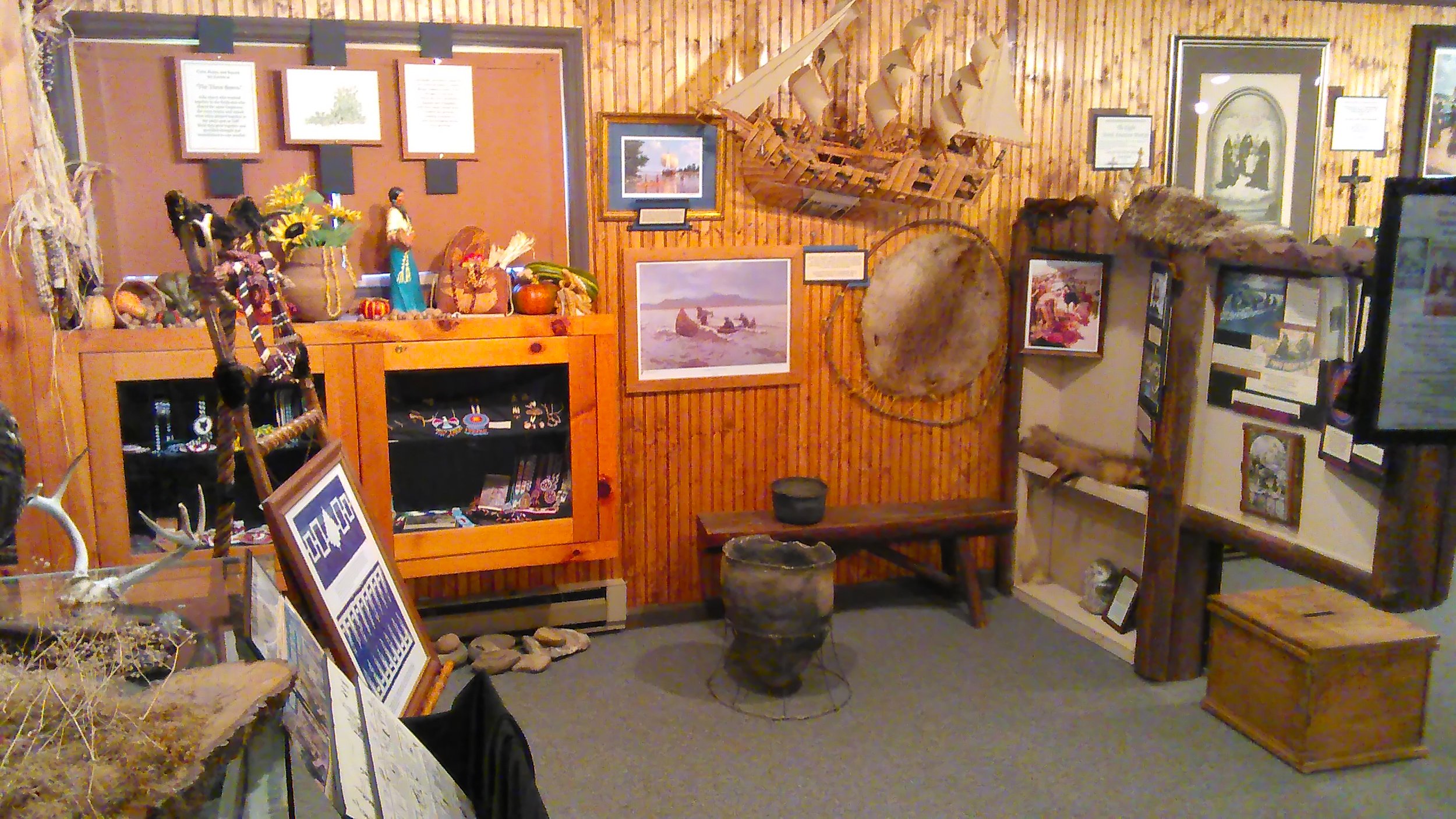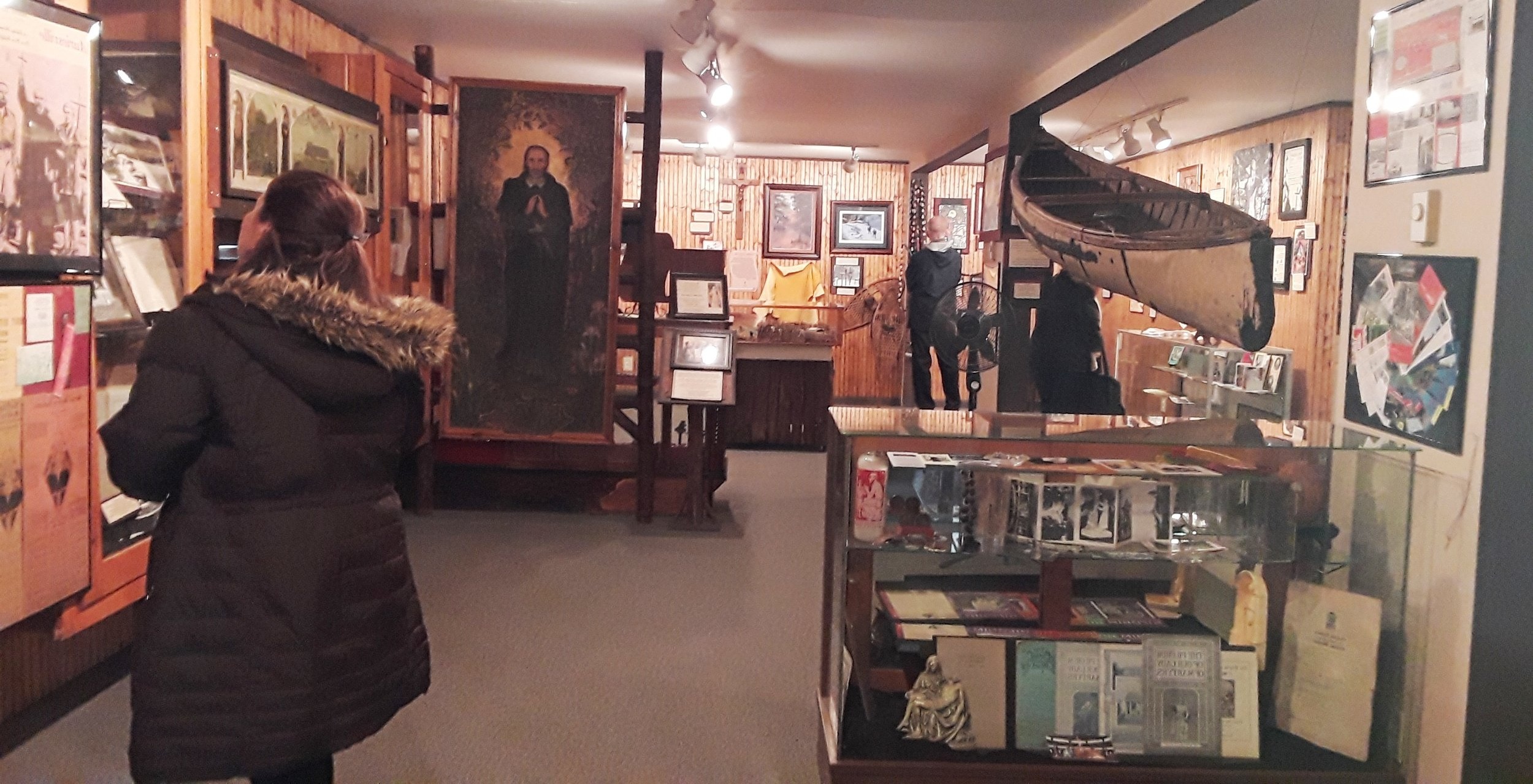A storyboard timeline runs through several venues: Mohawk life, initiation of trade with Europeans, the imprint of French and Dutch explorers, founding of Jesuit missions in Canada, the capture and martyrdoms of the three Jesuit missionaries at Auriesville – St. Isaac Jogues, St. René Goupil, and St. John Lalande – and from their blood sacrifice, the conversion of the Mohawk/Algonquin maiden, St. Kateri Tekakwitha.
Along the way pilgrims read the pictorial story boards, study the maps of the New World and locations of native tribes, view the small scale models of longhouses, villages, and missions, and view interpretive paintings of tribal and mission life. Everywhere is the ineffable planting of the cross of Christ.
As either an introduction or a wrap-up, pilgrims enjoy taking a seat in the museum to watch documentaries on the Shrine and the Auriesville Saints.
Along the way pilgrims read the pictorial story boards, study the maps of the New World and locations of native tribes, view the small scale models of longhouses, villages, and missions, and view interpretive paintings of tribal and mission life. Everywhere is the ineffable planting of the cross of Christ.
Exhibits in the Mohawk venue include bone and stone tools and weapons, colorful beadwork, and items used in religious ceremonies. Pilgrims can pet the animal pelts and wrap themselves in deerskins. They hold the sweet grass baskets and wampum shell beads; they crush the white sage in their hands and inhale its aroma. They pat the birch bark canoes, beat the drums, and lift the weighty stone tomahawk.
A classic Jesuit “black robe” hangs in the Ontario venue where details emerge of harsh life and stolid faith at the missions, where five of the eight North American Martyrs were killed. Here, pilgrims are introduced to some of the first indigenous converts.
The heroic saga of St. Isaac Jogues is told in L. F. Tantillo paintings, and in photographs of stained glass that colorfully crystalize highlights of his witness. Maps help pilgrims track his and St. René Goupil’s capture and trail to Ossernenon from the St. Lawrence River. The venue of Goupil’s death, and later his burial in the Ravine by the grief-stricken Father Jogues, is marked with rosaries, art, and interpretive captions.
The Dutch settlers of the Albany area play a major role in our saints’ story. Well beyond the exhibited wooden shoes, clay pipes, and signature tulips, these enterprising merchants had a great heart for the captive Father Jogues. They became his liberators, and his transport home to France.
The final venue is Father Isaac Jogues’ return as Peace Ambassador to the Mohawks. Here there is a mockup of Jogues’ mysterious “black box” that became the harbinger of death for him and St. John Lalande. Pilgrims can unpack its probable contents, handle chalices and priest stoles, and ring Communion bells before reaching the end of the lives of these two martyrs.
The storyboard picks up ten years later with the birth of St. Kateri Tekakwitha. Stylized paintings, and bronze, ceramic, and stone statuettes interpret her interior stages of conversion. Her diminished vision was a vestige of smallpox, her penchant for crafts a natural talent, and her survival in the wilderness an instinctual gift. Pilgrims can handle items that symbolize these traits: contemporary Mohawk baskets, pottery shards, and figurines of animals that identify the Mohawk clans.
But it was the Holy Spirit who instilled in her an insistent desire for spiritual truth. She found it in the Catholic faith of the Black Robe Jesuit missionaries. In this venue, pilgrims see a 19th century Iroquois catechism, a 17th century prayer bell, and a Mohawk hymnal. Via maps, photographs, and paintings, they follow her escape to the Jesuit missions near Montreal, and her untimely death there. The final venue is a celebration of her canonization in 2012.


